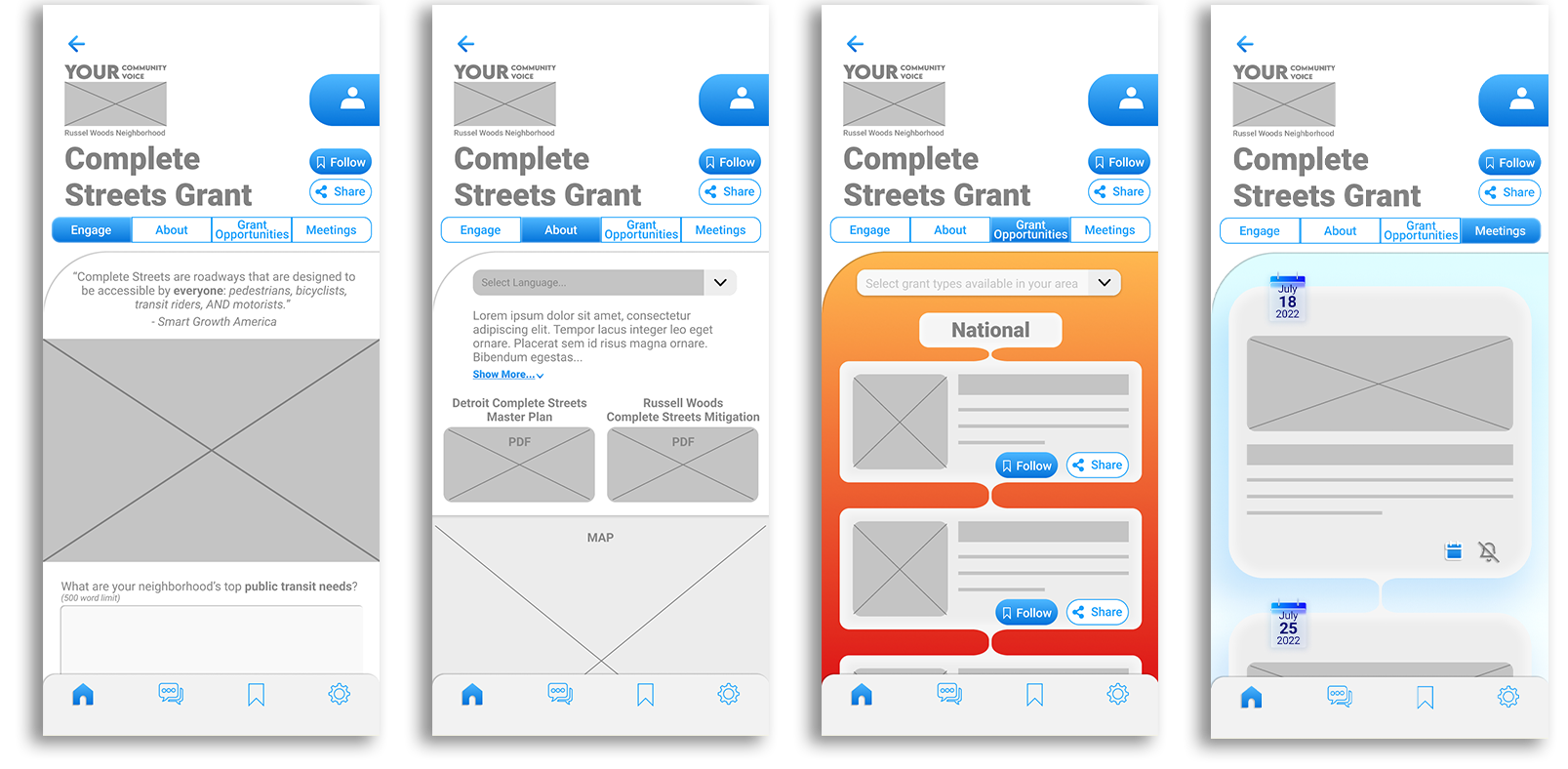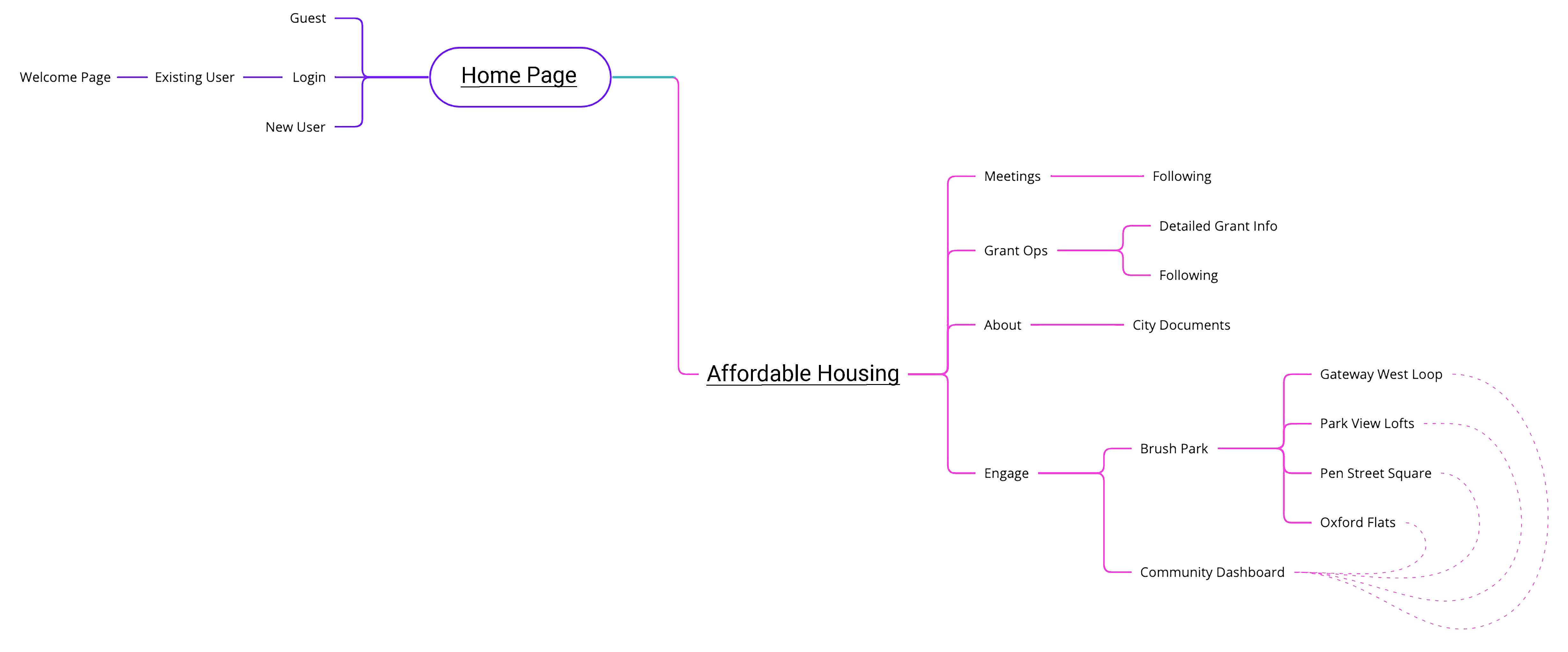
UX Designer
Client: City Parks & Planning Department
Primary User: Public / community engagement
Secondary User: Private A&E firms
Detroit, MI used as case study for prototype. The design focuses on accessibility and engagement.
Thesis Project Part 2
at the University of Colorado Boulder
Primary Advisor - Aileen Pierce
External Advisor - Jack Dille
March - April 2022
Illustrator, Photoshop, Figma, Miro

Identifying a Need
Public grants are notoriously difficult to find, hard to understand, and rarely is the community invited to engage and learn more about public grant opportunities. Furthermore, community engagement is one of the most critical aspects of any streetscape redesign, private development, park, or housing project.
I had the opportunity to work on the Russel Woods / Nardin Park Neighborhood Framework with Design Workshop and LOHA. My observations of severe housing blight & urban decay paralleled with world class innovative urban design & development made Detroit a prime city to use as a case study for a public grant community engagement platform.
Housing Extremes within Detroit



Previous Engagement Experience
- My previous community engagement experience in the city of Detroit proved to be incredibly insightful, but codifying the comments into usable data sets is a task that the city and private agencies are still greatly struggling with.


Dilemma
The fear in a city like Detroit is that there are so many new projects being funded, pursued, and built, that the community can end up feeling frustrated, left out, and ignored. Cities pursue public grants based off of the communities top priority needs and desires, but without a city wide accessible platform, many community members will have no say in which grants the city pursues, what grants the city is eligible for, and how current projects are carried out and built.

Hypothesis
- There needs to be a centralized tool for the city to manage, the community to engage with, and private firms to utilize to see what RFPs (request for proposals) are coming down the pipeline from the city.
-
- Through my participation in community meetings in Detroit, it was discovered the most accessible platform for community members to access is mobile app.
-

Beginning The Design Process
- At the end of the day, the community will be the ones voting to dictate which grants they feel the city should pursue. The intent of the Your Community Your Voice tool is that the community has the opportunity to see current grants the city is pursuing, engage in grant projects already underway, and follow and track upcoming grant opportunities they would like their city to pursue.
To make the app more manageable, there three main buckets the grants will be broken down to;
-



Info Architecture
- Before sketching out any concepts, I began with building the general info architecture for the three main grant topics.


Developing Use Cases & Prototyping
Wireframing
- I went through some use cases and personas to make a list of features to include. I also did some quick thumbnails of screens to help me understand the user flow and get a rough understanding of structure. I looked at different functions, like the ability to follow specific grants, add public meetings to your calendar, and creating fun project engagement that produces useful data citywide data. I decided to also develop a community dashboard, after completing some user testing that displays the engagement data from each grant topic.
-


Wireframing -> HiFi Prototyping

- Each of the three grant topics have a very similar layout. The key differences between the three categories is the engagement piece is unique to specific projects underway in that category. The about category will hold all city documents and overview of that grant topic. Grant opportunities will host national, state, and local grant opportunities that apply to that specific category. Lastly, users will be able to view any public meetings or forums happening that relate to that specific topic.



Complete Streets // User Demo

Wireframing -> HiFi Prototyping

- Depending on the city, certain topics may carry more weight for community engagement. For Detroit, the Urban Open Space engagement is critical for in the cities decision to decide where to spend their money. The engagement activity is composed of the user selecting the most desired location of six predetermined park locations (the city will have gone through a rigorous planning process to define these sites), selecting the amenities they would most like in those parks, and receiving a custom park design axon based off of their input.
-



Urban Open Space // User Demo

Wireframing -> HiFi Prototyping

- Affordable housing is arguably the most critical aspect of community engagement in city planning due the necessity of to offer equitable housing and the controversial nature of the topic. The engage portion of the affordable housing topic is designed in a way that does not allow users to leave nasty comments, nor vote down projects that have already been approved. The engagement instead focuses on bringing the community in on the design process and is targeting needs that can serve the community as a whole instead of just those in need of equitable housing. Engagement topics range from aesthetics all the way to preferred public infrastructure.




Urban Open Space // User Demo
Project Take-aways
One of the most important lessons I learned was how to design within the constraints of equitable community needs. There are few industries that rival architecture and planning engagement needs in terms of complexity. Uncovering the complexity of the neighborhood wants and desires, and identifying the community pain points was a daunting, yet critical task.
Creating a methodical process I could follow to identify these constraints proved extremely valuable.
The second most important lesson I learned is about accessibility. Approaching community engagement with an inclusive viewpoint can often yield amazing results. However, at times it can be stressful to make sure I am creating a platform accessible to the entire community. Valuing the time and opinion of community members and my user testing group was instrumental in the project's development, and in the design of the project.
Considering diverse perspectives yields amazing results.
If I were to take this project further, I would love to design the app hand in hand with a city department. The city's adoption of the product plays a crucial role in the success of the product. I would also create a metric to measure the product's success, and I would test the system's effectiveness in the real world.
If you're interested in this project and want to hear more, or just want to chat, feel free to contact me!